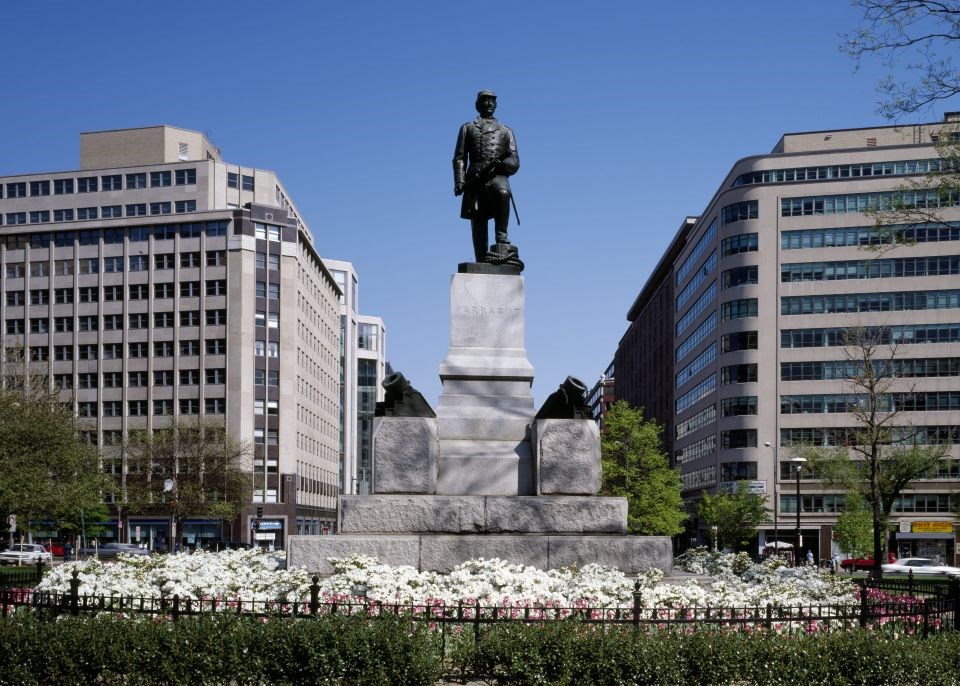
After the Civil War, the U.S. government raised a host of memorials and statues across Washington, D.C., to honor the men and women who had fought for the Union. One of these was the statue of a standing Admiral David G. Farragut at 17th and K Streets NW (in a park now known as Farragut Square). It was an appropriate location, as the spot had served as an encampment for Union artillery during the Civil War. Unlike some of his commanders, President Abraham Lincoln could rely from the start on Farragut and never had to replace him. Farragut became the first vice admiral and the first full admiral in the history of the U.S. Navy. The latter rank had been created specifically for him by Congress. On August 5, 1864, Farragut achieved a signature victory of the Civil War when his fleet captured Mobile Bay, the last remaining Confederate port along the Gulf of Mexico. The victory also provided President Lincoln a crucial victory prior to the 1864 election. It was during this battle where Farragut had himself lashed to the rigging of his flagship, the USS Hartford, directing the assault, and (allegedly) shouting, “Damn the torpedoes! Full speed ahead!” Following Farragut’s death in 1870 there was a groundswell of support to erect a memorial in his honor. In April 1872, Congress appropriated $20,000 for such a tribute and authorized a design competition. The award went to sculptor Lavinia “Vinnie” Ream, who in 1866 had been the first female artist commissioned to create a work of art for the United States government when she was selected by Congress to sculpt a memorial statue of President Abraham Lincoln. Working from photograph’s provided by Farragut’s widow, Virginia, Ream worked on the sculpture for six years, first in a studio in the nation’s capital before having it cast at the Washington Navy Yard. The completed work is a 10-foot portrait statue of Farragut, showing him standing as though on a ship’s deck with a telescope in his hand as he watches a naval engagement unfolding before him. The completed sculpture, as well as four mortars around its base, was cast from the bronze propeller of the USS Hartford. The statue was placed atop a massive, rusticated pedestal made of Maine granite, facing south towards Farragut’s birthplace in Tennessee. Within the pedestal was placed a box containing documents related to Farragut’s career and a miniature bronze model of the USS Hartford’s propeller. The Admiral David G. Farragut statue was unveiled on April 25, 1881, the 19th anniversary of the capture of New Orleans, a naval assault led by Farragut. The ceremony was held before 4,000 invited guests and thousands more spectators from the general public. Guests included President James A. Garfield and First Lady Lucretia Garfield; the Cabinet; Vinnie Ream; Virginia Farragut; the Capital City Guards, a unit of African American soldiers representing the city; and John Philip Sousa, who conducted the Marine Band. In accepting the statue on behalf of the American people, President Garfield presciently predicted that the nation’s capital would become home to more such monuments and memorials over the years: "As the years pass on, these squares and public places will be rendered more and more populous, more and more eloquently by the presence of the heroes of other days. Today we come to hail this hero, who comes from the sea, down from the shrouds of his flagship, wreathed with the smoke and glory of victory . . . to take his place as our honored compatriot, and a perpetual guardian of his country's glory."
|
Last updated: October 8, 2021
